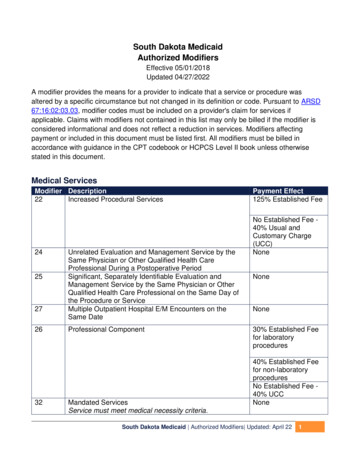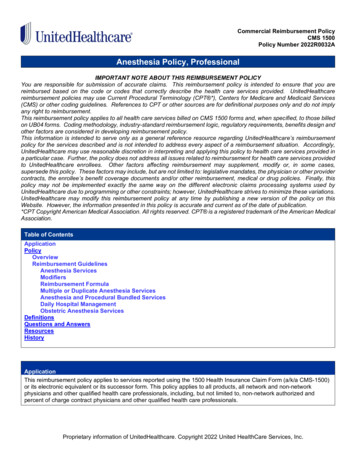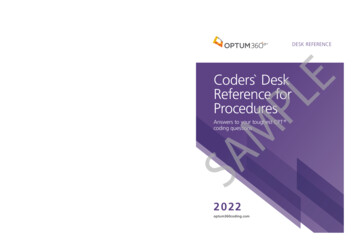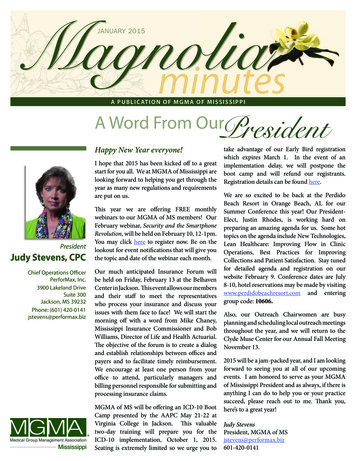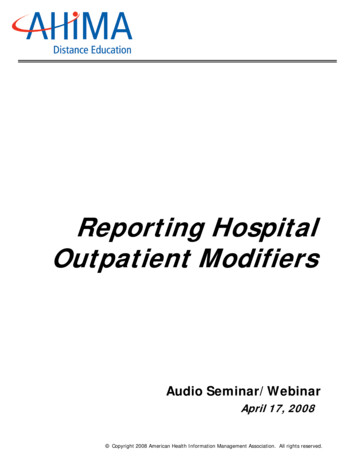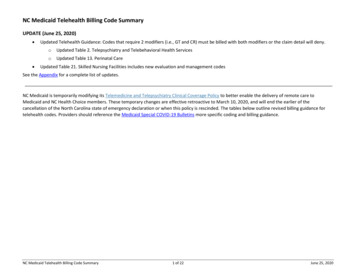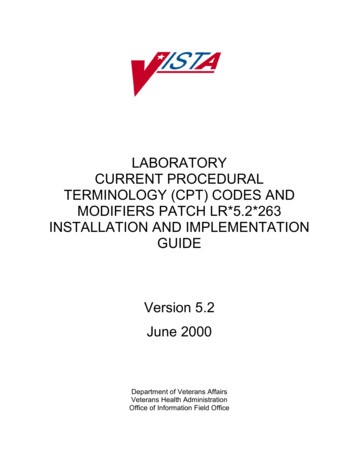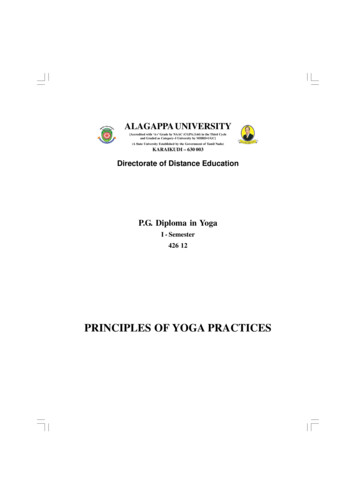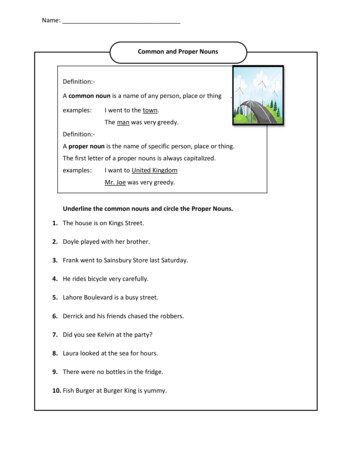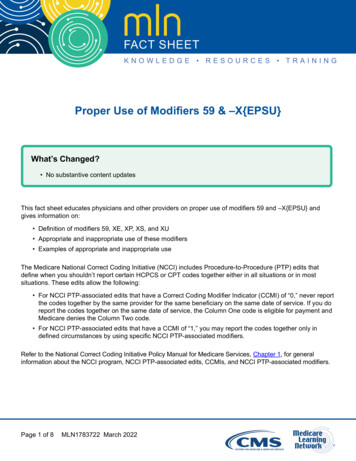
Transcription
FACT SHEETProper Use of Modifiers 59 & –X{EPSU}What’s Changed? No substantive content updatesThis fact sheet educates physicians and other providers on proper use of modifiers 59 and –X{EPSU} andgives information on: Definition of modifiers 59, XE, XP, XS, and XU Appropriate and inappropriate use of these modifiers Examples of appropriate and inappropriate useThe Medicare National Correct Coding Initiative (NCCI) includes Procedure-to-Procedure (PTP) edits thatdefine when you shouldn’t report certain HCPCS or CPT codes together either in all situations or in mostsituations. These edits allow the following: For NCCI PTP-associated edits that have a Correct Coding Modifier Indicator (CCMI) of “0,” never reportthe codes together by the same provider for the same beneficiary on the same date of service. If you doreport the codes together on the same date of service, the Column One code is eligible for payment andMedicare denies the Column Two code. For NCCI PTP-associated edits that have a CCMI of “1,” you may report the codes together only indefined circumstances by using specific NCCI PTP-associated modifiers.Refer to the National Correct Coding Initiative Policy Manual for Medicare Services, Chapter 1, for generalinformation about the NCCI program, NCCI PTP-associated edits, CCMIs, and NCCI PTP-associated modifiers.Page 1 of 8MLN1783722 March 2022
–X{EPSU}ProperMLNFactFactSheetSheetMLNOne purpose of NCCI PTP-associated edits is to prevent payment for codes that report overlapping servicesexcept where the services are “separate and distinct.” Modifier 59 is an important NCCI PTP-associatedmodifier that providers often use incorrectly.This fact sheet will help you use this modifier correctly.Definition of Modifiers 59, XE, XP, XS, and XUThe CPT Manual defines modifier 59 as follows:“Distinct Procedural Service: Under certain circumstances, it may be necessary to indicate thata procedure or service was distinct or independent from other non-E/M (Evaluation/Management)services performed on the same day. Modifier 59 is used to identify procedures/services, other thanE/M services, that are not normally reported together, but are appropriate under the circumstances.Documentation must support a different session, different procedure or surgery, different site or organsystem, separate incision/excision, separate lesion, or separate injury (or area of injury in extensiveinjuries) not ordinarily encountered or performed on the same day by the same individual.However, when another already established modifier is appropriate, it should be used rather thanmodifier 59. Only if no more descriptive modifier is available, and the use of modifier 59 best explainsthe circumstances, should modifier 59 be used.Note: Modifier 59 should not be appended to an E/M service. To report a separate and distinct E/Mservice with a non-E/M service performed on the same date, see modifier 25.”Don’t use modifiers 59, -X{EPSU} and other NCCI PTP-associated modifiers to bypass an NCCI PTP edit unlessthe proper criteria for use of the modifiers are met. Medical documentation must satisfy the required criteria.Effective January 1, 2015, XE, XS, XP, and XU are valid modifiers. These modifiers give greater reportingspecificity in situations where you used modifier 59 previously. Use these modifiers instead of modifier 59whenever possible. (Only use modifier 59 if no other more specific modifier is appropriate.)CMS allows the modifiers 59 or –X{ESPU} on Column One or Column Two codes (see the related transmittalat CR11168).We define these modifiers as follows: XE – “Separate Encounter, a service that is distinct because it occurred during a separate encounter.”Only use XE to describe separate encounters on the same date of service. XS – “Separate Structure, a service that is distinct because it was performed on a separate organ/structure” XP – “Separate Practitioner, a service that is distinct because it was performed by a different practitioner” XU – “Unusual Non-Overlapping Service, the use of a service that is distinct because it does not overlapusual components of the main service”Page 2 of 8MLN1783722 March 2022
e & Inappropriate Use of These Modifiers1. Using modifiers 59 or –XS properly for different anatomic sites during the same encounteronly when procedures which aren’t ordinarily performed or encountered on the same day areperformed on: Different organs, or Different anatomic regions, or In limited situations on different, non-contiguous lesions in different anatomic regions of thesame organModifiers 59 or –XS are for surgical procedures, non-surgical therapeutic procedures, or diagnosticprocedures that: Are performed at different anatomic sites, Aren’t ordinarily performed or encountered on the same day, and Can’t be described by one of the more specific anatomic NCCI PTP-associated modifiers – that is, RT,LT, E1-E4, FA, F1-F9, TA, T1-T9, LC, LD, RC, LM, or RI. (See examples 1, 2, and 3 below.)From an NCCI program perspective, the definition of different anatomic sites includes different organs or, incertain instances, different lesions in the same organ. We created NCCI edits to prevent the inappropriate billingof lesions and sites that aren’t considered separate and distinct. The treatment of contiguous structures in thesame organ or anatomic region doesn’t generally constitute treatment of different anatomic sites. For example: Treatment of the nail, nail bed, and adjacent soft tissue distal to and including the skin overlying thedistal interphalangeal joint on the same toe or finger constitutes treatment of a single anatomic site.(See example 4 below.) Treatment of posterior segment structures in the ipsilateral eye constitutes treatment of a singleanatomic site. (See example 5 below.)2. Only use modifiers 59 or -XE if no other modifier more properly describes the relationship of the2 procedure codes.Another common use of modifiers 59 or –XE is for surgical procedures, non-surgical therapeutic procedures,or diagnostic procedures that are performed during different patient encounters on the same day that can’t bedescribed by one of the more specific NCCI PTP-associated modifiers – that is, 24, 25, 27, 57, 58, 78, 79, or91. (See example 7 below.)Page 3 of 8MLN1783722 March 2022
–X{EPSU}ProperMLN Fact Sheet3. Don’t use modifiers 59 or –XU just because the code descriptors of the 2 codes are different.One of the common misuses of modifier 59 relates to the part of the definition of modifier 59 allowing its useto describe a “different procedure or surgery.” The code descriptors of the 2 codes of a code pair edit describedifferent procedures, even though they may overlap. Don’t report the 2 codes together if they’re performed atthe same anatomic site and same patient encounter, because they aren’t considered “separate and distinct.”Don’t use modifiers 59 or –XU to bypass a PTP edit based on the 2 codes being “different procedures.”(See example 8 below.)However, if you perform 2 procedures at separate anatomic sites or at separate patient encounters on the samedate of service, you may use modifiers 59 or –X{ES} to show that they’re different procedures on that date ofservice. Also, there may be limited circumstances sometimes identified in the National Correct Coding InitiativePolicy Manual for Medicare services when you may report the 2 codes of an edit pair together with modifiers 59or –X{ES} when performed at the same patient encounter or at the same anatomic site.4. Other specific proper uses of modifiers 59 or -X{EU}.There are 3 other limited situations where you may report 2 services as separate and distinct because they’reseparated in time and describe non-overlapping services even though they may occur during the same encounter.A. Using modifiers 59 or –XE properly for 2 services described by timed codes providedduring the same encounter only when they are performed one after another. There’s anappropriate use for modifier 59 that’s applicable only to codes for which the unit of service is ameasure of time (two examples are: per 15 minutes or per hour). If you provide 2 timed servicesin time periods that are separate and distinct and aren’t mingled with each other (that is, youcomplete one service before the next service begins), you may use modifiers 59 or –XE to identifythe services. (See example 9 below.)B. Using modifiers 59 or –XU properly for a diagnostic procedure which is performed before atherapeutic procedure only when the diagnostic procedure is the basis for performing thetherapeutic procedure. When you perform a diagnostic procedure before a surgical procedure ornon-surgical therapeutic procedure and it’s the basis on which you decide to perform the surgicalprocedure or non-surgical therapeutic procedure, you may consider that diagnostic procedure to be aseparate and distinct procedure if it:a. Occurs before the therapeutic procedure and isn’t mingled with services the therapeuticintervention requiresb. Provides clearly the information needed to decide whether to proceed with the therapeuticprocedure; andc. Doesn’t constitute a service that would have otherwise been required during the therapeuticintervention (See example 10 below.)If the diagnostic procedure is an inherent component of the surgical procedure, don’t report it separately.Page 4 of 8MLN1783722 March 2022
Proper Use of Modifiers 59 & –X{EPSU}MLNFactFactSheetSheetMLNC. Using modifiers 59 or –XU properly for a diagnostic procedure which occurs after acompleted therapeutic procedure only when the diagnostic procedure isn’t a common,expected, or necessary follow-up to the therapeutic procedure. When a diagnostic procedurefollows the surgical procedure or non-surgical therapeutic procedure, you may consider thatdiagnostic procedure to be a separate and distinct procedure if it:a. Occurs after the completion of the therapeutic procedure and isn’t mingled with or otherwisemixed with services that the therapeutic intervention requiresb. Doesn’t constitute a service that would have otherwise been required during the therapeuticintervention. If the post-procedure diagnostic procedure is an inherent component orotherwise included (or not separately payable) post-procedure service of the surgicalprocedure or non-surgical therapeutic procedure, don’t report it separately.Use of modifiers 59 or –X{EPSU} doesn’t require a different diagnosis for each HCPCS or CPT codedprocedure. On the other hand, different diagnoses aren’t adequate criteria for use of modifiers 59 or –X{EPSU}.The HCPCS or CPT codes remain bundled unless you perform the procedures at different anatomic sites orseparate patient encounters or meet one of the other 3 scenarios described by A, B, or C above.Examples of Appropriate & Inappropriate UseExample 1: Column 1 Code/Column 2 Code - 11102/17000 CPT Code - 11102 - Tangential biopsy of skin (eg, shave, scoop, saucerize, curette); single lesion CPT Code - 17000 - Destruction (g, laser surgery, electrosurgery, cryosurgery, chemosurgery, surgicalcurettement), premalignant lesions (eg, actinic keratoses); first lesionYou may report modifiers 59 or -XS with either the Column 1 or Column 2 code if you did the proceduresat different anatomic sites on the same side of the body and a specific anatomic modifier isn’t applicable. Ifyou did the procedures on different sides of the body, use modifiers RT and LT or another pair of anatomicmodifiers. Don’t use modifiers 59 or -XS.The use of modifier 59 or -XS is appropriate for different anatomic sites during the same encounter only whenprocedures (which aren’t ordinarily performed or encountered on the same day) are performed on differentorgans, or different anatomic regions, or in limited situations on different, non-contiguous lesions in differentanatomic regions of the same organ.Example 2: Column 1 Code/Column 2 Code - 47370/76942 CPT Code - 47370 - Laparoscopy, surgical, ablation of 1 or more liver tumor(s); radiofrequency CPT Code - 76942 - Ultrasonic guidance for needle placement (eg, biopsy, aspiration, injection,localization device), imaging supervision and interpretationPage 5 of 8MLN1783722 March 2022
ProperUseUseofofModifiersModifiers5959& &–X{EPSU}–X{EPSU}ProperMLN Fact SheetDon’t report CPT code 76942 with or without modifiers 59 or –X{EPSU} if the ultrasonic guidance is forneedle placement for the laparoscopic liver tumor ablation procedure 47370. Only report 76942 withmodifiers 59 or –X{EPSU} if the ultrasonic guidance for needle placement is unrelated to the laparoscopicliver tumor ablation procedure.Example 3: Column 1 Code/Column 2 Code - 93453/76000 CPT Code - 93453 - Combined right and left heart catheterization including intraprocedural injection(s)for left ventriculography, imaging supervision and interpretation, when performed CPT Code - 76000 - Fluoroscopy (separate procedure), up to 1 hour physician or other qualified healthcare professional timeDon’t report CPT code 76000 with or without modifiers 59 or –X{EPSU} for fluoroscopy in conjunction with acardiac catheterization procedure. You may report 76000 with modifiers 59 or –X{EPSU} if the fluoroscopy isperformed for a procedure unrelated to the cardiac catheterization procedure.Example 4: Column 1 Code/Column 2 Code - 11055/11720 CPT Code - 11055 - Paring or cutting of benign hyperkeratotic lesion (eg, corn or callus); single lesion CPT Code - 11720 - Debridement of nail(s) by any method(s); 1 to 5Don’t report CPT codes 11720 and 11055 together for services performed on skin distal to and including theskin overlying the distal interphalangeal joint of the same toe. Don’t use modifiers 59 or –X{EPSU} if youdebride a nail on the same toe on which you pare a hyperkeratotic lesion of the skin on or distal to the distalinterphalangeal joint. You may report modifier 59 or –XS with code 11720 if you debride 1 to 5 nails andyou pare a hyperkeratotic lesion on a toe other than 1 with a debrided toenail or the hyperkeratotic lesion isproximal to the skin overlying the distal interphalangeal joint of a toe on which you debride a nail.Example 5: Column 1 Code/Column 2 Code - 67210/67220 CPT Code - 67210 - Destruction of localized lesion of retina (eg, macular edema, tumors), 1 or moresessions; photocoagulation CPT Code - 67220 - Destruction of localized lesion of choroid (eg, choroidal neovascularization);photocoagulation (eg, laser), 1 or more sessionsDon’t report CPT code 67220 with or without modifier 59 or –X{EPSU} if you perform both procedures duringthe same operative session because the retina and choroid are contiguous structures of the same organ.Example 6: Column 1 Code/Column 2 Code - 29827/29820 CPT Code - 29827 - Arthroscopy, shoulder, surgical; with rotator cuff repair CPT Code - 29820 - Arthroscopy, shoulder, surgical; synovectomy, partialPage 6 of 8MLN1783722 March 2022
Proper Use of Modifiers 59 & –X{EPSU}MLN Fact SheetDon’t report CPT code 29820 with or without modifiers 59 or –X{EPSU} if you perform both procedures on thesame shoulder during the same operative session. If you perform the procedures on different shoulders, usemodifiers RT and LT, not modifiers 59 or –X{EPSU}.Example 7: Column 1 Code/Column 2 Code - 93015/93040 CPT Code - 93015 - Cardiovascular stress test using maximal or submaximal treadmill or bicycleexercise, continuous electrocardiographic monitoring, and/or pharmacological stress; with supervision,interpretation, and report CPT Code - 93040 - Rhythm ECG, 1-3 leads; with interpretation and reportYou may report modifiers 59 or –XE if you interpret and report the rhythm ECG at a different encounter thanthe cardiovascular stress test. If you interpret and report a rhythm ECG during the cardiovascular stress testencounter, don’t report 93040 with or without modifier 59. You may report modifiers 59 or –XE when youinterpret and report the procedures in different encounters on the same day.Example 8: Column 1 Code/Column 2 Code - 34833/34820 CPT code - 34833 - Open iliac artery exposure with creation of conduit for delivery of endovascularprosthesis or for establishment of cardiopulmonary bypass, by abdominal or retroperitoneal incision,unilateral (List separately in addition to code for primary procedure) CPT code - 34820 - Open iliac artery exposure for delivery of endovascular prosthesis or iliac occlusionduring endovascular therapy, by abdominal or retroperitoneal incision, unilateral (List separately inaddition to code for primary procedure)CPT code 34833 is followed by a CPT Manual instruction that states: “(Do not report 34833 in conjunction with33364, 33953, 33954, 33959, 33962, 33969, 33984, 34820 when performed on the same side).” Although theCPT code descriptors for 34833 and 34820 describe different procedures, don’t report them together for thesame side. Don’t add modifiers 59 or –X{EPSU} to either code to report 2 procedures for the same side of thebody. If you performed 2 procedures on different sides of the body, you may report them with modifiers LT andRT as appropriate. However, modifiers 59 or –X{EPSU} are inappropriate if the basis for their use is that thenarrative description of the 2 codes is different.Example 9: Column 1 Code/Column 2 Code - 97140/97750 CPT Code - 97140 - Manual therapy techniques (for example, mobilization/manipulation, manuallymphatic drainage, manual traction), 1 or more regions, each 15 minutes CPT Code - 97750 - Physical performance test or measurement (for example, musculoskeletal,functional capacity), with written report, each 15 minutesPage 7 of 8MLN1783722 March 2022
ProperUseUseofofModifiersModifiers5959& &–X{EPSU}–X{EPSU}ProperMLN Fact SheetYou may report modifier 59 if you perform 2 procedures in distinctly different 15-minute time blocks. Forexample, you may report modifier 59 if you perform 1 service during the initial 15 minutes of therapy andyou perform the other service during the second 15 minutes of therapy. As another example, you may reportmodifier 59 if you split the therapy time blocks by performing manual therapy for 10 minutes, followed by 15minutes of physical performance test, followed by another 5 minutes of manual therapy. Don’t report CPT code97550 with modifier 59 if you perform 2 procedures during the same time block. You may report modifier 59when you perform 2 timed procedures in 2 different blocks of time on the same day.Example 10: Column 1 Code/Column 2 Code - 37220/75710 CPT Code - 37220 - Revascularization, endovascular, open or percutaneous, iliac artery, unilateral, initialvessel; with transluminal angioplasty CPT Code - 75710 - Angiography, extremity, unilateral, radiological supervision, and interpretationYou may report modifier 59 or –XU with CPT code 75710 if youhaven’t already performed a diagnostic angiography and youbase the decision to perform the revascularization on the result ofthe diagnostic angiography. The CPT Manual defines additionalcircumstances under which you may report diagnostic angiographywith an interventional vascular procedure on the same artery. Youmay report modifier 59 or –XU for a diagnostic procedure performedbefore a therapeutic procedure only when the diagnostic procedureis the basis for performing the therapeutic procedure.Together we can advancehealth equity and help eliminatehealth disparities for all minorityand underserved groups. Findresources and more from theCMS Office of Minority Health: Health Equity TechnicalAssistance Program Disparities Impact StatementResources National Correct Coding Initiative webpage MLN Article, Modification of the MCS Claims Processing System Logic for Modifier 59, XE, XS, XP, andXU Involving the National Correct Coding Initiative (NCCI) Procedure to Procedure (PTP) Column Oneand Column Two Codes National Correct Coding Initiative Policy Manual for Medicare ServicesCPT only copyright 2021 American Medical Association. All rights reserved.Medicare Learning Network is a registered trademark of CMS.Medicare Learning Network Content Disclaimer, Product Disclaimer, and Department of Health & HumanServices DisclosurePage 8 of 8MLN1783722 March 2022
Proper Use of Modifiers 59 & -X{EPSU} Page 4 of 8 MLN1783722 March 2022. Proper Use of Modifiers 59 & -X{EPSU} MLN Fact Sheet. 3. Don't use modifiers 59 or -XU just because the code descriptors of the 2 codes are different.
